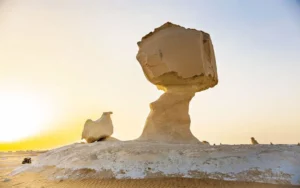
- Profile
- Tour Operators
- Accommodation
- prev
- next
- Get directions
- Bookmark
- Share
- Become an influencer
- prev
- next
Overview
Upon first glimpse of the 300-sq-km national park of the White Desert, you’ll feel like Alice through the looking-glass. About 20km northeast of Farafra, on the east side of the road, blinding-white chalk rock spires sprout almost supernaturally from the ground, each frost-coloured lollipop licked into a surreal landscape of familiar and unfamiliar shapes by the dry desert winds.
These sculptural formations are best viewed at sunrise or sunset, when the sun lights them with orangey-pink hues, or under a full moon, which gives the landscape a ghostly Arctic appearance. The sand around the outcroppings is littered with quartz and different varieties of deep-black iron pyrites, as well as small fossils. On the west side of the Farafra–Bahariya highway, away from the wind-hewn sculptures, chalk towers called inselbergs burst from the desert floor into a spectacular white canyon. Between them run grand boulevards of sand, like geologic Champs-Élysées. No less beautiful than the east side of the road, the shade and privacy here makes it a great area to camp.
About 50km north are two flat-topped mountains known as the Twin Peaks, a key navigation point for travellers. A favourite destination of local tour operators, the view from the top of the surrounding symmetrical hills, all shaped like giant ant-hills, is spectacular. Just beyond here, the road climbs a steep escarpment known as Naqb As Sillim (Pass of the Stairs); this is the main pass that leads into and out of the Farafra depression and marks the end of the White Desert.
A few kilometres further along, the desert floor changes again and becomes littered with quartz crystals. If you look at the rock formations in this area you’ll see that they are also largely made of crystal. The most famous of the formations is the Crystal Mountain, actually a large rock made entirely of quartz. It sits right beside the main road some 24km north of Naqb As Sillim, and is easily recognisable by the large hole through its middle.
At the time of writing, foreigners were officially no longer allowed to camp overnight in the desert, but in reality many people do. The tourist police turn a blind eye, but it pays to do the trip with an experienced safari outfit. As well as the national park entry fee, you pay a LE20 fee for each night you sleep here. If you come as part of a group, the fees are included in your tour. You can usually buy tickets at the entrance to the park, but don’t worry about going in without one; you can just pay the rangers when they find you. Sleeping anywhere in the park, surrounded by the white formations and visited by friendly fennecs, is an unforgettable experience.
Location
-
Al Farafra, New Valley, Egypt
Vital Park Information
Egypt
When visiting Egypt, don't drink the tap water - it's highly chlorinated. ... It's a similar situation in Egypt. It is advisable to drink bottled water during your entire holiday. That is why I would advise strongly that you don't drink the tap water and use it only for washing and brushing your teeth.
Egyptian pound
Low Risk - Not necessary to take anti-malaria drugs





